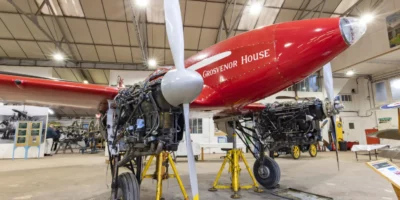Last weekend, I bolted my Citroen diesel engine to the front of my Jodel… It’s a spanner job that’s already been a long time coming, and it represents a minor personal milestone rather than a glorious destination, as there’s still some way to go. Pipes and wires to connect, radiator to install, wiring to do (more on that later), gauges to fit and connect, and cowls to make pretty… Well maybe that bit’s not possible without starting from scratch, so let’s say ‘modification to existing cowls’ to be completed, and so on. Hopefully though, the old adage normally trotted out when talking of firewalls (90% finished, 90% still to go) won’t apply in this case, because I built up the whole installation on a stand with a dummy wall. With just a couple of minor clashes, it all seems to fit.
Even getting ready for the bolt up took a lot longer than I’d expected, and it was a lot more arduous. I’m not as flexible as I would like, or used to be, but I’m still much the same height, and the Jodel features a large spar carry-through running across the cabin which requires you to lie upside down across it to get your head under the panel. If you wear glasses, the focal length is then too short. There is also the fuel tank which goes between the firewall and the panel and traps most of the wires coming through. I tried, and I tried again, but there was nothing for it but to summon smaller and more agile assistance.
“You want to rip the whole lot out and just start again”
“You know what you want to do with all that,” said Andy, as he surveyed the vast mass of tangled wires, some of it heavy, armoured and colour coded, obviously dating from 1964, some of it white and random from the 8.33 era – and some already bearing bits of tape with legends in pen, laboriously applied by me. “You want to rip the whole lot out and just start again,” was my helper’s blunt assessment. “It’ll be so much easier than trying to work out what someone else has done…”
He’s right, of course, but there was something already troubling about the vast pile of aviation-specific technology filling a large table, all of it apparently essential for the flight which brought the aeroplane here. Electronic ignition boxes to spark the Potez engine, several junction boxes, numerous fuel system parts, gascolator and pipes, cable-operated master switch, alternator regulator, battery box, controls for mixture, carb heat and – the substantial dual throttle arrangement which refused to leave until we dropped the fuel tank. And of course, the two panels. In this particular Jodel each is mounted on long flexible stalks, which bring the vacuum-operated flight instruments clear of the fuel tank on the left, and the radio and transponder on the right. At least removal of all this made the cockpit immediately more spacious, a detail that Avions Robin applied to the 200 series which came soon after.
We picked through the pile of parts, just to be sure. No ignition system on a diesel, so that was one large heap. Fuel system stuff made up another, but there still seemed to be a very large one related to the electrical system. I would now need only one wire from the alternator to the battery, one to the electronic rev counter and one each to start and run the electric pump. No carb heat and no mixture controls. One exhaust pipe rather than two. Maybe the burning of oil is just simpler as well as more frugal.
There is too a large choice of modern electronic instruments, all occupying a great deal less space. I could even opt for just two screens, one each side of the panel, if I could afford them, but I’ll probably go for the ubiquitous remote head radio and transponder and an iPad, plus some matching automotive gauges. As someone said, ‘you can spot a needle out of place whereas you have to read a number and process the information’. Maybe sometime, when I know the engine works…
The engine side of the firewall certainly looked less busy after my efforts, but there’s no doubt it had left a lot of holes. I counted 115 of them, and no, that’s not a guess. Some would need to be filled again, but there were plenty that wouldn’t. Might have been better to start again there too, but this is mainly an engine research project, so I have been trying to deal with the essentials in order so I can prove the motive parts. If it doesn’t work as I hope, then there is the depressing reality of having to put some of the stuff mounting up on the table back on the aeroplane. Best not think about that… As Andy said, “It’s an engine designed to do 150,000 miles without attention. Why wouldn’t it work…”
It’s not quite that simple of course. The engine will be attached to parts for which it wasn’t designed, and there are details like torsional vibration, which still cause headaches for automotive designers (it’s why your car features an expensive dual mass flywheel…), let alone amateur builders of aviation reduction drives.
The entire firewall forward assembly which incorporates their choice has actually been ready since the middle of the first lockdown, but I had been hitherto loath to mount it, just in case someone in authority decided I shouldn’t be doing it like that, or something. Since ‘they’ haven’t said anything much over the last 18 months, I’ve decided to press ahead anyway. I’ll let you know how it goes…
Working vintage aircraft and cars make Mark particularly happy.
[email protected]







